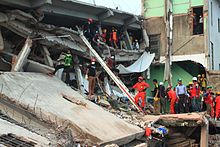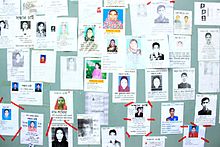
collapse-Rana Plaza

2013 Savar building collapse
From Wikipedia, the free encyclopedia
(Redirected from Rana Plaza)
| Date | 24 April 2013 |
|---|---|
| Time | 08:45 am BST (UTC+06:00)[1] |
| Location | Savar Upazila, Dhaka District, Bangladesh |
| Coordinates | 23°50′46″N 90°15′27″ECoordinates: 23°50′46″N 90°15′27″E |
| Also known as | Rana plaza building collapse |
| Deaths | 1,129[2] |
| Injuries | ~2,500[3] |
It is considered to be the deadliest garment-factory accident in history, as well as the deadliest accidental structural failure in modern human history.[7][8]
The building contained clothing factories, a bank, apartments, and several other shops. The shops and the bank on the lower floors immediately closed after cracks were discovered in the building.[3][9][10] Warnings to avoid using the building after cracks appeared the day before had been ignored. Garment workers were ordered to return the following day and the building collapsed during the morning rush-hour.[11]
Collapse and rescue
The building collapsed at about 09:00, leaving only the ground floor intact.[3] The Bangladesh Garment Manufacturers and Exporters Association president confirmed that 3,122 workers were in the building at the time of the collapse.[26] One local resident described the scene as if "an earthquake had struck."[27]Within hours of the collapse, the United Nations offered to send expert rescue teams with dogs, micro-cameras and other equipment to the site, but this offer was rejected by Dhaka authorities.[28]
One of the garment manufacturers' websites indicates that more than half of the victims were women, along with a number of their children who were in nursery facilities within the building.[11] Bangladeshi Home Minister Muhiuddin Khan Alamgir confirmed that army, fire service personnel, Police and Rapid Action Battalion troops were assisting with the rescue effort.[10] Volunteer rescue workers used bolts of fabric to assist survivors to escape from the building.[29] A national day of mourning was held on 25 April.[10]
On 8 May an army spokesman, Mir Rabbi, said the army's attempt to recover more bodies from the rubble would continue for at least another week.[30] On 10 May, 17 days after the collapse, a woman named Reshma was found and rescued alive and almost unhurt under the rubble.[31][32][33][34]
Aftermath
Bangladesh
The day after the Rana Plaza building collapse, the Dhaka city development authority filed a case against the owners of the building and the five garment factories operating inside it.[26] On the same day, dozens of survivors were discovered in the remains of the building.[35] Although at first Prime Minister Sheikh Hasina had denied the membership of Rana in the Jubo League, after intense criticism of her speech she ordered the arrest of Sohel Rana and four of the owners of the garment factories operating in the building.[36][37] Sohel Rana was reported to have gone into hiding;[36] however, authorities reported that four other individuals had already been arrested in connection with the collapse.[38]Two days after the building collapse, garment workers across the industrial areas of Dhaka, Chittagong and Gazipur rioted, targeting vehicles, commercial buildings and garment factories.[39] The next day, leftist political parties and the BNP-led 18 Party Alliance demanded the arrest and trial of suspects and an independent commission to identify vulnerable factories.[40] Four days after the building collapsed, the owner of the Rana Plaza, Sohel Rana, was arrested at Benapole, on the Indo-Bangladeshi border, in Jessore District by security forces.[41][42][43][44] On the same day a fire broke out at the disaster site and authorities were forced to temporarily suspend the search for survivors.[45]
On 1 May on International Workers' Day, Protesting workers paraded through central Dhaka by the thousands to demand safer working conditions and the death penalty for the owner of Rana Plaza.[46] A week later hundreds of survivors of Bangladesh's worst industrial disaster blocked a main highway to demand wages, as the death toll from the collapse of a nine-storey building passed 700.[47][48] Local government officials said they had been in talks with the Bangladesh Garment Manufacturers and Exporters Association for the workers to be paid their outstanding April salaries plus a further three months – £97. After officials promised the surviving workers that they would be soon paid, they ended their protest. The government and garment association were compiling a list of surviving employees to establish who must be paid and compensated.[49] The next day, 18 garment plants, including 16 in Dhaka and two in Chittagong, were closed down. Textile minister, Abdul Latif Siddique, told reporters that more plants would be shut as part of strict new measures to ensure safety.[50]
On 5 June, police in Bangladesh opened fire on hundreds of former workers and relatives of the victims of the collapse who were protesting to demand back pay and compensation promised by the government and the Bangladesh Garments Manufacturers and Exporters Association.[51]
On 10 June, seven inspectors were suspended and accused of negligence for renewing the licenses of garment factories in the building that collapsed.[52]
On 22 September, at least 50 people were injured when police fired rubber bullets and tear gas into a crowd of protesters who were blocking streets in Dhaka demanding a minimum wage of $100 (8,114 takas) a month.[53]
International legal action
See also: Chandler v Cape plc
It had been reported on Channel 4 News, in the UK, that Primark and other UK High Street firms were in negotiations with trade unions over compensation to the families of the victims.[54] This could pre-empt substantial liability for compensation in English tort law for the parent companies who sold the products, following the Court of Appeal case Chandler v Cape plc.[55] Since Lubbe v Cape plc,
involving a worker for a South African subsidiary company who
contracted an asbestos disease, it has been possible in English courts
for workers abroad who have injuries from health and safety violations
to bring claims against the multinational corporations who use their
products.[56] The law has changed since significant litigation was launched after the Bhopal disaster in 1984.Worldwide criticism
Politicians
Nick Clegg, current UK Deputy PM and leader of the Liberal Democrats said: "... there's more we could do to talk about what goes on behind the scenes and this terrible catastrophe might well prompt people to think again."[57]Michael Connarty, UK's Falkirk East MP, is calling on the UK Government to push through new legislation to end modern day slavery by forcing major High Street companies in the UK to audit their supply chain. The framework will request those companies to make vigorous checks to ensure slave labour is not used in third world countries, and the UK, to produce their goods.[58]
Karel De Gucht, current European Commissioner for Trade, warned that retailers and the Bangladeshi government could face action from the EU if nothing is done to improve the conditions of workers – adding that shoppers should also consider where they are spending their money.[59]
The Pope
On 1 May, Pope Francis spoke out against the working conditions in the factory:- 'A headline that really struck me on the day of the tragedy in Bangladesh was 'Living on 38 euros a month'. That is what the people who died were being paid. This is called slave labour. Today in the world this slavery is being committed against something beautiful that God has given us – the capacity to create, to work, to have dignity. How many brothers and sisters find themselves in this situation! Not paying fairly, not giving a job because you are only looking at balance sheets, only looking at how to make a profit. That goes against God!'[60][61]
Advocacy groups
Human Rights Watch stated their concern over the number of factory-building tragedies in Bangladesh; there have been numerous major accidents in the country in the past decade, including the 2012 Dhaka fire.[62]Industrial Global Union, a global union federation representing textile and garment workers' trade unions around the world, launched an online campaign in support of the Bangladeshi unions' demand for labour law reform in the wake of the disaster. The campaign, hosted on Labour Start, calls for changes in the law to make it easier for unions to organise workers, as well as demanding improved health and safety conditions.[63]
On 27 April, protesters surrounded Primark store on Oxford Street in the City of Westminster in the West End of London. Speaking outside the store, Murray Worthy, from campaign group War on Want, said:
- ‘We’re here to send a clear message to Primark that the 300 deaths in the Bangladesh building collapse were not an accident – they were entirely preventable deaths. If Primark had taken its responsibility to those workers seriously, no one need have died this week.’[64]
Consumers
Dozens of consumers in the United States spoke out against unsafe working conditions found in the factory building. People also unleashed their anger at retailers that did not have any connections to that specific building, but are known to source from factories located in Bangladesh.[65]Fashion industry response
At a meeting of retailers and NGOs a week after the collapse, a new Accord on Factory and Building Safety in Bangladesh was created and a deadline of 16 May was set to sign it.[66] The agreement expands on a previous accord signed only by the US-based PVH which owns Calvin Klein and Timberland, and German retailer Tchibo.Walmart, along with 14 other North American companies, refused to sign the accord as the deadline passed.[67] As of 23 May 2013, thirty-eight companies had signed the accord.[68] Walmart, J.C. Penney and labour activists have been considering an agreement to improve factory safety in Bangladesh for at least two years.[30] In 2011, Walmart rejected reforms that would have had retailers pay more for apparel to help Bangladesh factories improve safety standards.[21][69]
On July 10, 2013, a group of 17 major North American retailers, including Walmart, Gap, Target and Macy’s, announced a plan to improve factory safety in Bangladesh, drawing immediate criticism from labor groups who complained that it was less stringent than an accord reached among European companies. Unlike the accord joined mainly by European retailers, the plan lacks legally binding commitments to pay for those improvements.[70]
Joe Fresh will send representatives from Canada to inspect their supply chains in Bangladesh.[14] The Irish brand Primark will review the structural integrity of buildings making its clothes.[71]
Dov Charney the founder & CEO of American Apparel was interviewed on Vice.tv and spoke out against the poor treatment of workers in developing countries and refers to it as "slave labor." Charney proposes a "Global Garment Workers Minimum Wage" as well discusses in detail many of the inner workings of the modern Fast fashion industry commerce practices that leads to dangerous factory conditions like at Savar [72]
Compensation to victims
The Irish brand Primark will offer compensation to the victims of the collapse[73] As of mid-September 2013, compensations to families of disaster victims were still under discussion, with many families struggling to survive after having lost a major wage earner.[74] Families who had received the $200 compensation from Primark were only those who were able to provide DNA evidence of their relative's death in the collapse, something which proved extremely difficult to do according to the BBC reporter covering the story.[75] The U.S. government provided DNA kits to the families of victims.[76]The Canadian retailing giant Loblaws Companies Ltd. who own the Joe Fresh brand using the factory has promised up to $77 million CAD in long-term compensation. They will follow the example set by Primark and use much of the same funding framework.[77]














No comments:
Post a Comment